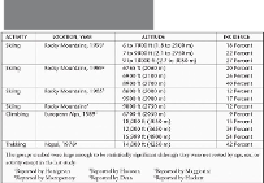Travel Reference
In-Depth Information
AMSisthatrapidascentcausesgeneralizedwaterretention,butinsusceptiblepeoplemore
fluid collects in the brain.
A few individuals develop an unsteady gait (ataxia), an important sign of brain involve-
ment. If a person begins to stumble and fall or becomes drowsy and apathetic, he or she
should be considered to have high-altitude cerebral edema (HACE). (High-altitude pul-
monary edema—fluid in the lungs—may be present, too, increasing the hypoxia.) Such in-
dividualsareingreatdanger,andrapiddescent—withsupplementaloxygenifpossible—is
essential.
AMS can be prevented by gradual acclimatization at intermediate altitudes, or, to some
extent,bymedication.TheincidenceorfrequencyofAMSincreaseswithaltitudeasshown
in
Table24-3
.OnlyafewpersonshaveAMSat6500feet(2000m),butaftergoingrapidly
from near sea level to over 14,000 feet (4300 m) more than half have symptoms.
Children and adults are equally susceptible to AMS, but recognizing symptoms in in-
fants or young children who cannot verbalize their symptoms requires awareness of the
problem. The incidence of AMS is decreased in the elderly, possibly because the normal
cerebral atrophy of aging leaves more space for a swollen, edematous brain.
NoneofthesymptomsofAMSisspecific.Theyalsooccurinpeoplewhoareexhausted,
dehydrated, hypoglycemic, hypothermic, suffering from carbon monoxide poisoning, tak-
ing prescription or recreational drugs, or developing an infection. Usually the individual's
history of rapid ascent, together with absence of other causes, makes the diagnosis likely.
A high fever suggests infection; AMS does not cause a high fever unless complicated by
another condition.
Table 24-3
Incidence of Acute Mountain Sickness
Anyone who has recently come to high altitude and has the listed symptoms should be
treated for AMS, unless another cause is strongly suspected. Anyone who continues to get
worse in spite of rest should be taken to a lower altitude. Supplemental oxygen is helpful
for providing restful sleep but is not a substitute for descent if a person is ill. In the hands
of medically trained personnel, simulated descent in a portable hyperbaric chamber, such
as a Gamow Bag, may be a safe alternative to actual descent. (This is discussed in more
detail in “High-Altitude Cerebral Edema,” this chapter.)

Search WWH ::

Custom Search